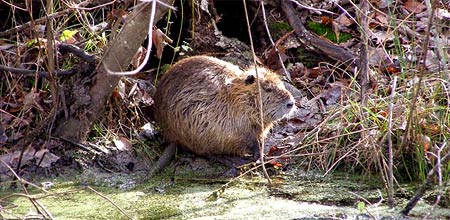
HOW TO COOK A MYOCASTOR COYPUS
By Bob Jamison
Bon jour mes amis! That is, what they might say in certain restaurant districts of Baton Rouge, Louisiana. What they are talking about in plain Texas language is a readily abundant wild animal that lives amongst us. Actually, this one is an edible four legged animal few people know a lot about eating and some might not care to do so. However, one of the interesting facts is that according to our Cajun friends, the coypus has gained the reputation of being the Louisiana organic meat. This is because its diet is strictly vegetable plants. Also, the meat of the coypus is said to be a quite healthy red meat. It is lean, plus it has 50% less cholesterol than chicken. The meat is 22% protein, and l.2 % fat. So where could you go wrong with that?
Introduced to this country from South America for control of certain noxious plants in the bayous and canals, this interesting animal has reproduced dramatically and is sought after for food, fur and, in some areas, bounties. The bounty comes in places where depredations have occurred to rice fields and even sugar cane crops. Plus, damage to the famous march sea cane that harbors a multitude of wildlife which might be threatened.
But with all the problems with the abundance of this animal, it is still recognized for its importance by the Louisiana Wildlife Department. Also, it has gained quite a reputation with a significant number of chefs and has become prominent as table fare in some homes of south Louisiana. This is in concert with the ever popular coypus cook-offs and the offering of countless recipes by the young and old folks alike. Following are some suggestions for your next culinary experience that will, no doubt, lift the eyebrows of your informed guest.
After the animal is cleaned and washed, place hind legs and back in a baking dish. Paint lightly with mustard, honey, salt, cracked pepper, add carrots, onions, red wine (two tblsp), margarine and pop into the oven at 325 degrees for about fifteen minutes or until brown on both sides. Then add one quart of water, cover with foil and bake for forty five minutes more. Take the dish out of the oven, serve and then pour over cuts of meat with the sauce that follows.
Make the sauce contents in a similar way as the meat preparation. Use honey, mustard and vinegar. Add a little more red wine, a dash of Dijon mustard, two tablsp of cream and cook the sauce until almost boiling and pour lightly over the meat in each serving dish. Garnish with colorful vegetables and a large potato wedge. Hmmm: Cest bon!
By the way, should your dinner guest inquire about the great tasting dish, a discussion of the actual facts might be in order. First of all, you might impress your guest with your knowledge of the Greek language. That is, the word Myocastor can be broken down in two words; myo and castor. Myo is from the Greek word mouse and the word castor is the word for beaver; or mouse beaver, or even ‘beaver rat’. The coypus is the actual scientific name for the animal.
Now we local folks seldom use the scientific names of animals or plants. In the case of the coypus we simply call it by its common name, “The Nutria”. Bon appetite!